Read Time: 5 Minutes Subscribe & Share
The Big Switch
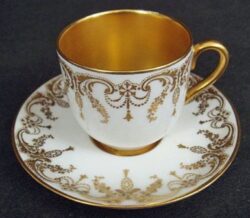 My mother served tea some afternoons after school with cinnamon toast or her molasses cookies. She and my father drank a demi-tasse of Nescafe or Sanka many evenings with an occasional brandy. In the mornings, they, like my husband’s parents, used something called a percolator to make coffee. Growing up, I thought it tasted awful. Nescafe just tasted peculiar. Later at college, I tried drinking coffee instead of tea but could hardly bear it. People told me to add more milk, and that it would be more pleasant with a some sugar. Again I tried, but did not persevere.
My mother served tea some afternoons after school with cinnamon toast or her molasses cookies. She and my father drank a demi-tasse of Nescafe or Sanka many evenings with an occasional brandy. In the mornings, they, like my husband’s parents, used something called a percolator to make coffee. Growing up, I thought it tasted awful. Nescafe just tasted peculiar. Later at college, I tried drinking coffee instead of tea but could hardly bear it. People told me to add more milk, and that it would be more pleasant with a some sugar. Again I tried, but did not persevere.
It was not until I had coffee in Germany and Austria as a student, that I began to understand its appeal. Of course, my introduction to the divine pastries of the Austro-Hungarian Empire that I ate with it, certainly helped blunt the edges. Later, when my husband and I went to France, we thought the coffee there was even better and discovered what my parents meant by demi-tasse. And then many years later, when we tracked down our daughters in Italy and took a chance on caffé normale we finally understood the genuine joy of coffee.
Quality Over Quantity
The current teeny cup with a few sips of an intense coffee topped with a foamy surface is actually a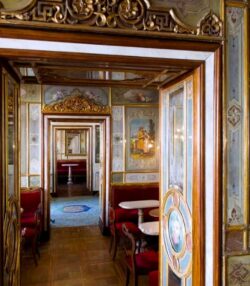 recent transition for coffee in Italy. Records show that coffee existed in 16th century Venice, and the Serenissima City State was one of the first to import its own coffee beans. In fact, you can, for a fairly stiff price, still go to Caffe Florian and have a coffee and pastry in the oldest coffee house in the world that is still pulling shots.
recent transition for coffee in Italy. Records show that coffee existed in 16th century Venice, and the Serenissima City State was one of the first to import its own coffee beans. In fact, you can, for a fairly stiff price, still go to Caffe Florian and have a coffee and pastry in the oldest coffee house in the world that is still pulling shots.
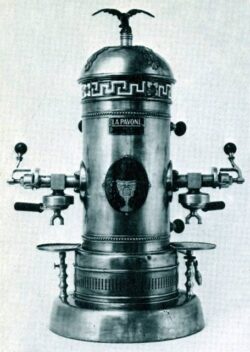 But the idea of creating a coffee that was individually produced for each customer evolved from the inventions of Angelo Moriondo, who produced in small numbers machines that controlled the supply of steam and water through ground coffee beans in 1884. These machines, although patented, were kept for the coffee bars his company owned in Turin. They did not produce individual cups of coffee on demand. In 1901, an engineer, Luigi Bezzara, revised this machine (some believe he had worked for Moriondo) so that it could produce small amounts of coffee with the steam and hot water control, in a quick and cost effective way. A few years later, his improved patents were purchased by Desidero Pavoni, and the individually prepared cups of coffee became wildly popular wherever his machines were used.
But the idea of creating a coffee that was individually produced for each customer evolved from the inventions of Angelo Moriondo, who produced in small numbers machines that controlled the supply of steam and water through ground coffee beans in 1884. These machines, although patented, were kept for the coffee bars his company owned in Turin. They did not produce individual cups of coffee on demand. In 1901, an engineer, Luigi Bezzara, revised this machine (some believe he had worked for Moriondo) so that it could produce small amounts of coffee with the steam and hot water control, in a quick and cost effective way. A few years later, his improved patents were purchased by Desidero Pavoni, and the individually prepared cups of coffee became wildly popular wherever his machines were used.
It’s The Details
These machines produced a coffee that today would be a good filtered coffee, as they could exert only about 4 BARs (a measure of pressure). A stovetop Bialetti Moka pot produces between 1 and 2 BARs. This is a mildly controversial subject among espresso coffee nerds, who can argue over such topics as the efficacy of electric water boilers vs pump-driven boilers in espresso machines. To make it easier for mere coffee-drinking mortals, I quote the website Coffeelife.com:
The BAR measurement (known as barometric pressure) is essentially the number of atmospheres of pressure exerted upon coffee grounds. A BAR of 9, for example, indicates that the pressure of the water being pushed through the coffee grounds is 9 times that of Earth’s standard atmospheric pressure of 1 BAR.
Currently machines capable of producing a decent espresso must reach 9 BARs (minimum is 7 for barely passable espresso). These are now being challenged by machines with a capacity of up to 20 BARs. These machines, which are usually pump-based, produce the crema which we found, like many before us, so intoxicating. In fact, during a period when La Cuisine featured the coffee from Gianni Frasi, the founder of Giamaica Caffe, we visited him in his laboratorio in Verona and were treated to an excruciatingly long lesson in the intricacies of coffee beans, the roasting thereof and the final product, which had 25% crema – a must according to Sgr. Frasi. We also stood fascinated as we watched his wood-fired coffee bean roaster exude flames. I’m proud to say it was actually manufactured in Bologna! Although we had to recover from our visit with a terrific meal with two wines and a few digestivi, his not-too-dark roasted cups of espresso were extraordinary.
All this might lead one to believe that in drinking an Italian espresso, you are mainlining caffeine. This is actually not true. From personal experience, drinking a big American cup of coffee usually gives me a sort of jittery headachy feeling. Drinking an espresso, I just feel pleasantly recharged with the benefit of the chocolaty crema as a bonus. A shot of espresso is about an ounce and has a bit over 60mg of caffeine, while a normal serving of American coffee is usually close to 10 oz and can pack up to around 160mg of caffeine. Side note: the little glass of water that is served with your espresso is a charming Italian extra – you are to drink some to cleanse your palate so that you can better enjoy the flavor of the coffee.
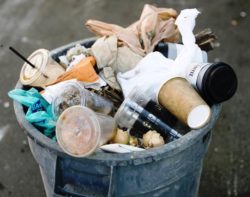 Most American coffee is made with various strains of Robusta coffee, which packs more caffeine per bean. I did find out that long roasting reduces caffeine but the difference is apparently negligible. I think it is best to find a coffee that is 100% Arabica. Robusta, which grows at lower altitudes, has a higher yield per bush, has about double the caffeine as Arabica and a more acidic taste profile. A
Most American coffee is made with various strains of Robusta coffee, which packs more caffeine per bean. I did find out that long roasting reduces caffeine but the difference is apparently negligible. I think it is best to find a coffee that is 100% Arabica. Robusta, which grows at lower altitudes, has a higher yield per bush, has about double the caffeine as Arabica and a more acidic taste profile. A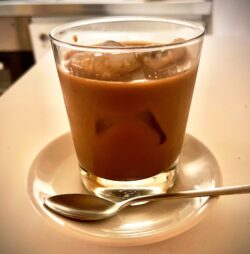 very prominent coffee roaster and coffee house owner in Alexandria once said to me that Americans really like coffee-flavored milk. Looking at the drinks from Starbucks, which come in mysteriously named over sized cups, I think he has a point.
very prominent coffee roaster and coffee house owner in Alexandria once said to me that Americans really like coffee-flavored milk. Looking at the drinks from Starbucks, which come in mysteriously named over sized cups, I think he has a point.
On a personal level, I’m doing my part to create some American coffee inroads in Italy – but only for the good bits. During some miserably hot weather, I started squirreling away ice cubes (tiny ice cube trays accompany most Italian freezers) and introduced my son-in-law to Iced Coffee, American style, although served in smaller glasses. He loved it.

Kitchen Detail shares under the radar recipes, explores the art of cooking, the stories behind food, and the tools that bring it all together, while uncovering the social, political, and environmental truths that shape our culinary world.




Wonderful reflection on your coffee adventure. I don’t believe we discussed coffee while at your store but I occasionally would purchase the La Sameuse. In the mid 1980’s while visiting Italy I brought home a La Pavoni expresso maker, a fine machine but not for the faint of heart. More art than science. On a rainy morning locate JS Bach’s Coffee Cantata (BWV 211), great music but the lyrics are a must.
Ciao Andy!
Wonderful music selection! I had never heard of this piece. And bravo to you for trying a La Pavoni. You are right, it is more art than science. I tried at a friend’s house and the results were erratic, to put it kindly. La Semeuse is a great coffee and it is even sold here despite it its being a Swiss producer!
I don’t drink American version it in fact I like black Turkish coffee. If you have some suggestions on a machine with the high bars please put them in a post. The stove top mocha just doesn’t cut it Laura
Hi Laura,
I have been told that one should buy a pump driven one and currently the Solis Barista Gran Gusto (what a fancy number of marketing words!) from Switzerland. is highly recommended. Let me know what you think,